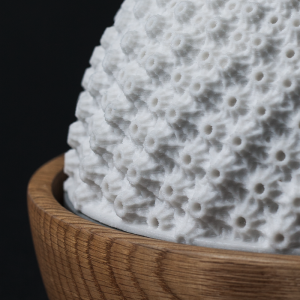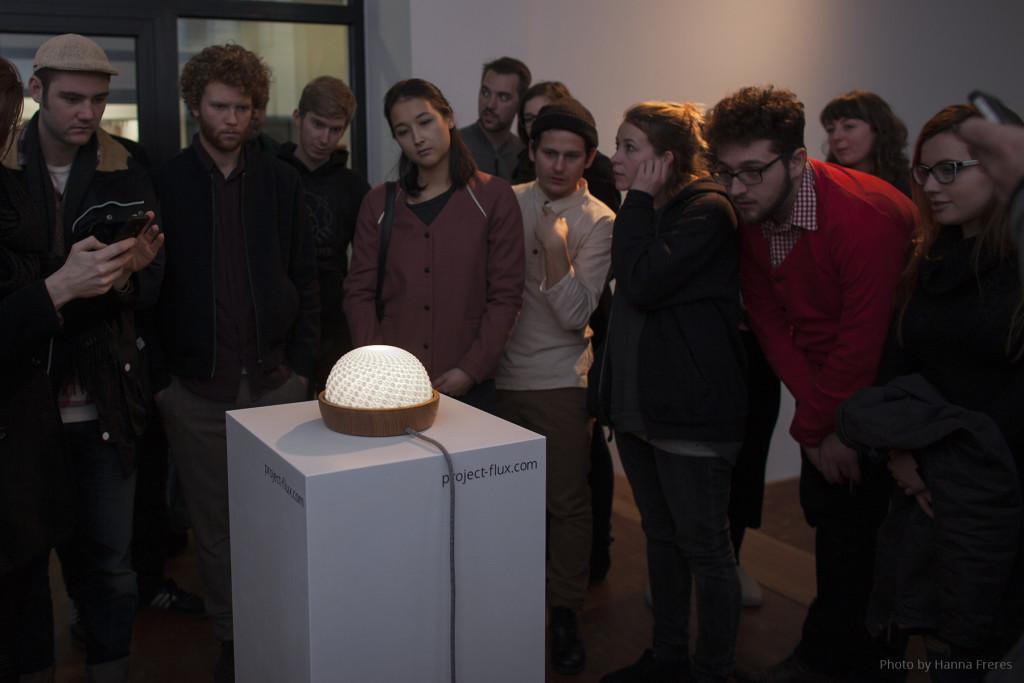 You may, at first glance, mistake it for some strange, exotic sea creature – a newly discovered species of jellyfish, perhaps, or sea urchin. Whatever it is, it’s beautiful. Luminous, undulating, it literally glows with life as it rotates in its bowl, beads of white sliding across its surface. It’s not a creature, though – in fact, incredibly, its surface is not even moving. This may seem impossible – I mean, look at it, it’s clearly moving, right? Nope. The only movement is a slow rotation, despite the fact that the surface seems to be crawling. That’s the power of optical illusion and mathematics.
You may, at first glance, mistake it for some strange, exotic sea creature – a newly discovered species of jellyfish, perhaps, or sea urchin. Whatever it is, it’s beautiful. Luminous, undulating, it literally glows with life as it rotates in its bowl, beads of white sliding across its surface. It’s not a creature, though – in fact, incredibly, its surface is not even moving. This may seem impossible – I mean, look at it, it’s clearly moving, right? Nope. The only movement is a slow rotation, despite the fact that the surface seems to be crawling. That’s the power of optical illusion and mathematics.
While Flux seems magical, its “movement” is thanks to the Fibonacci sequence, a relatively simple mathematical concept that lends itself to some amazingly complex theories and applications. The kinetic, 3D printed sculpture was created by Frederik Scheve, Janno Ströcker and Dieter Pilger, students at the Köln International School of Design, and 3D printed via Shapeways. They were inspired by Blooms, a series of 3D printed zoetropes created by artist John Edmark. Unlike Blooms, however, which utilizes a high speed camera to create the illusion of movement, Flux appears to move without any outside influence.
I’ll be completely honest – I don’t fully understand how it was done, but that’s the beauty of illusion. According to Flux’s creators:
“We envisioned a sculpture that displays an animation in the open physical space. The sphere is constructed according to the fibonacci sequence. It rotates in a certain speed and gets illuminated in a specific frequency. The animation can be seen just by looking at it with your eyes. No external devices like a strobe or a camera are required.”
 The illumination comes from a light installed inside the 3D printed sculpture. The beadlike protrusions on its surface were designed based on the Fibonacci principle, which is what makes them seem to slide along as the sculpture rotates. When I was a kid, I had several books of optical illusions that mesmerized me and also gave me wicked headaches if I stared at them for too long; it never occurred to me, at the time, to wonder about the many mathematical sequences that went into their design. Now, looking at Flux, I can see that it’s basically a 3D version of those optical illusion spirals I was so fascinated by.
The illumination comes from a light installed inside the 3D printed sculpture. The beadlike protrusions on its surface were designed based on the Fibonacci principle, which is what makes them seem to slide along as the sculpture rotates. When I was a kid, I had several books of optical illusions that mesmerized me and also gave me wicked headaches if I stared at them for too long; it never occurred to me, at the time, to wonder about the many mathematical sequences that went into their design. Now, looking at Flux, I can see that it’s basically a 3D version of those optical illusion spirals I was so fascinated by.
“Visual information is forwarded to the brain, where it is processed, interpreted and translated into sensory impressions,” the designers explain. “Generally speaking, visual perception is the product of filtering and reducing data, which enables us to depict our environment distinctly.”
Whoever said math and art have nothing to do with each other? Well – I did, as a sullen, math-hating art student in high school. I’ve since learned how very wrong I was. Mathematical concepts form the basis of so many great works of art, and Flux beautifully illustrates how magical those concepts can be. Discuss this incredible design in the 3D Printed Kinetic Sculpture forum thread on 3DPB.com.
Subscribe to Our Email Newsletter
Stay up-to-date on all the latest news from the 3D printing industry and receive information and offers from third party vendors.
Print Services
Upload your 3D Models and get them printed quickly and efficiently.
You May Also Like
3D Printing News Briefs, January 15, 2026: Project Call, Sports Medicine, Aluminum Alloy, & More
In today’s 3D Printing News Briefs, America Makes announced the winners of a $1.1 million Project Call, Austal USA named a new Vice President for Business Development and External Affairs,...
US Army Awards Contract to Phillips Federal for Containerized WAAM Factories
Everything that the U.S. Army has been doing with additive manufacturing (AM) over the last year or so suggests that the branch is getting serious about deployable production systems. One...
Top 10 3DPrint.com Stories of 2025: Kickstarter, Consumer Goods, Bankruptcy, & More
As Vanesa Listek wrote, last year was a major turning point for additive manufacturing (AM), as the industry is working to sort itself out. Customers want proven use cases and...
3D Printing News Briefs, January 3, 2026: F-15 Replacement Part, Ice Trees, & More
Happy New Year! We’ve got an abbreviated 3D Printing News Briefs for you today, so we can all enjoy our holiday weekend but still keep up on the industry’s news....






























